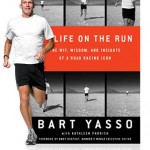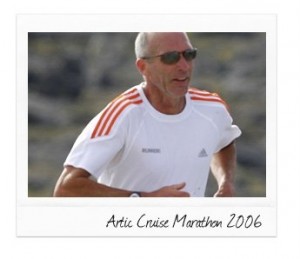Bart Yasso has what many would consider a dream career. His title is Chief Running Officer at Runner’s World (how cool is that?). Over three decades at the magazine, he became a high-profile and well-liked ambassador for the sport, getting paid to travel and run races in remote areas all over the world. To runners and race organizers, he’s a rock star.
I learned about his career through his book My Life on the Run: The Wit, Wisdom, and Insights of a Road Racing Icon in which he reveals that he excelled as a runner and thrived as a world traveler in spite of—and perhaps because of—an early adulthood overshadowed by drinking and drugs. These days, at 55, he still keeps busy promoting running events and inspiring beginners even though pain from chronic Lyme disease severely limits his ability to run.
I normally don’t go for breezy memoirs that reflect on career accomplishments and challenges overcome. But when I picked up his book (published by Rodale in 2008) and saw the phrase “Never Limit Where Running Can Take You” in the first line, I became intrigued. A few paragraphs in, I was hooked.
Bart puts into words a spirit that I hope to emulate and spread through this site: “In my life, running has also been a vehicle of introduction—to people, places, cultures, and animals. I have run on all seven continents, but it’s not the details of the races I recall. … The interesting stuff, the humorous stuff—memorable, life-affirming, and worth-reading stuff—is the meeting of a stranger, the stamp on a passport, the glimpse of a never-before-seen sight, the outlandish adventure. Running may be the connective tissue, but the true essence of the sport is a passage to a bigger world. So open the door and run through.”
Read on for more about the book, followed by an epilogue with video of his greatest race and then our Q&A.
The Book: My Life On the Run
Until I read My Life on the Run, I knew Bart Yasso only as the person behind Yasso 800s—the simplest yet most effective speed workout and marathon predictor. Yasso 800s work like this: Want to run a 3 hour, 15 minute marathon? Then work up to the point where you can do ten repeats of 800-meter intervals at 3 minutes, 15 seconds (with a 400m recovery jog between them). Want to run a 2:55 marathon? Then run those 800 meters repeatedly in 2 minutes, 55 seconds. Bart pinpointed the eerily accurate correlation between the hours and minutes of a marathon time to the minutes and seconds of 800-meter intervals. I used his formula over the years to gauge my fitness level and reach marathon PRs.
My Life on the Run traces Bart’s journey from an inauspicious beginning in Pennsylvania as a self-described “runt of the litter” and “unexceptional middle child of seven.” Smoking pot and drinking Boone’s Farm apple wine blurred his adolescence. Instead of going to college, he spent four years working a dead-end job and drinking half a case of Pabst Blue Ribbon nightly. But his lifestyle began to change when a series of events prompted him to start running. The story that unfolds charts Bart’s evolution as a runner who repeatedly finds himself in far-flung destinations facing daunting, sometimes preposterous challenges to run races as part of his promotions job for Runner’s World. The book also includes pages of useful training advice and a guide to “Must-Do Races Near and Abroad.”
The chapters pile on wild yet understated anecdotes from India, Africa, the Arctic, and elsewhere abroad. In a few cases the writing sacrifices depth for breadth, and I wish he (or rather, the writer who helped him author the book, Kathleen Parrish) had slowed down to capture more drama and complexity about his endeavors. In a chapter about riding his bike solo across the country in just 20 days, for example, he tosses off lots of one-liners in abbreviated diary entries but barely digs into deeper reflections about the trip.
The story that really got me took place here in California, in 1989. A lot of people today—well, a lot of ultrarunners, anyway—know of the Badwater Ultra from Death Valley to 14,496-foot Mount Whitney. Back then the course was 146 miles (now it’s 135). The Runner’s World publisher at the time heard about it and volunteered Bart to do it—no matter that Bart had never run more than a 26.2-mile marathon, or that only nine people had completed Badwater in the two years it had been an official race, or that temperatures could reach 134 degrees. Bart lined up with just five other runners at the start.
“This was before reality television turned ultra athletes into celebrities, and running 26.2 miles was considered extreme. It was also before the Internet was as ubiquitous as the cell phone, so the average person had no idea a race of this proportion even existed,” he writes. Knowing how core ultrarunners today view Badwater as a pinnacle achievement for which they spend years training, it boggles my mind to think that Bart did it with so little preparation. He guts it out with good humor in the best example of the “just do it” motto I’ve heard in a long time.
Incredibly, and sadly, Bart’s toughest challenge and worst enemy turned out to be a tiny deer tick. In June 1997, two-thirds of the way up Mount Kilimanjaro, he realized he was extremely ill with a fever and a partial paralysis of his face. He belatedly got a diagnosis of Lyme disease, contracted by the tick’s bite, which advanced to a dangerous stage. He underwent intense medical treatment and got it under control—until 2001, when he was in Italy to honeymoon. At 45, he married ultrarunner Laura Kulsik, and they celebrated by running the Rome Marathon right after their wedding. His joint pain from Lyme disease flared up drastically, and he suffered through the run and then underwent more treatment. Five years later, the disease returned full force, “inflating my knees like basketballs.” Doctors told him he couldn’t run.
He took the news in the most gracious and gutsy way I can imagine—which is one thing I admire greatly about this book and the man: the absence of self-pity, and the abundance of gratitude. “In the end, I didn’t quit. I decided that however many miles were left in my body, I would use them judiciously, waiting for a glorious morning when it would be neither too hot nor cold, and then only running on a scenic trail. I still consider myself a lifetime runner, but I only go two or three miles at a time. I made peace with it after recognizing that running isn’t about how far you go but how far you’ve come. Looking back at my checkered youth, I knew I’d traveled very far indeed.”
Throughout, he demonstrates the power of running to spark discovery of self and of the world. “A lot of people become complacent, or maybe just too comfortable, with their choices and don’t feel the need to shake up things or seek new experiences. I could have chosen that path, and for the first 20 or so years of my life I did,” he writes. “But then I started running. And when I started running, I started dreaming. It couldn’t be helped. The mind works as hard as the body does during exercise.”
Amen, ain’t that the truth.
The Epilogue: Comrades Marathon
Bart’s story ends with a cliffhanger of sorts. He has one real regret: that he never ran the 56-mile Comrades Marathon in South Africa. “It is the one race that still haunts my dreams. So I wonder, can this 52-year-old man with bum knees go 56 miles through the hills of South Africa? Is there another epic race left in me? Or will it go down as my greatest regret? The starting line beckons.”
Sounds like the setup to a reality show, and sure enough, Runner’s World produced an article and series of videos to document Bart taking on the challenge and triumphing. This moving multimedia epilogue is tinged by the patina of a publicity package, but no matter—I found myself tearing up and cheering all the way to the end. The first of seven episodes on the RW site is below. I particularly liked Episode 6, which portrays the beauty and culture of South Africa.
The Q&A
I emailed Bart a few questions, and he sent the following replies:
Last year, at age 54, you fulfilled your dream and capped your running career by finishing Comrades. What’s next for you—what are your goals for 2011 and beyond?
“I feel very fortunate to have my job at Runner’s World where I can still connect with runners all over the world and stay engaged in the running community. I don’t really have any personal running goals crossing any finish lines in 2011, but I will be encouraging thousands of runners as they pursue their running goals.”
How much are you running now, and how do you feel when you run? Are you in as much pain as you were in 2010 when you did those marathons for training and said, “I hurt from the minute the race starts ’til it’s over”?
“My Lyme disease limits my running. I like to do one run per week of 4 to 5 miles. Yes, I have lots of joint pain on the right side of my body. If I can get in that one run per week, it makes me feel alive.”
Is there any place you would like to travel and run, hike, or bike around the world that you haven’t already been?
“I am always ready for adventure travel to exotic locations. The more exotic and remote, the better. I would like to experience many more cultures and countries.”
If you could return to one destination in 2011—either in the U.S. or abroad—where you ran a race earlier in life and run it again, what would it be?
“Mt. Kilimanjaro, Moshi, Tanzania”
What advice do you have for older runners who struggle to come to terms with slowing down and coping with aches and pains that limit their ability to run?
“Embrace it, enjoy it; it’s part of the journey and just have fun with it. Last year I was crossing marathon finish lines about 90 minutes slower than my PR. The excitement and the reward factor was still the same. What was different for me is I was surrounded by lots of runners. The mid-pack of a marathon is the perfect location for me to connect with runners. The marathon finish line is a very special place and can’t be taken for granted.”
Thank you, Bart!



Nice story and Q&A, Sarah. About 10 years ago my good trail buddy Lon Monroe ran the Vermont 100-miler. Lon ended up running 20 hours, and to this day Lon still recounts what made the difference that year: Bart and his wife Laura were Lon’s pacers/crew. Bart’s been the difference to so many runners over the years. What a nice, honorable man, and what a nice bit of writing you’ve done to honor his work.
Great story Sarah,
What an inspirational character –
Particularly liked his take on running
“……Running may be the connective tissue, but the true essence of the sport is a passage to a bigger world. So open the door and run through……”
No matter what your level as a runner – you can always open that door
Gaz